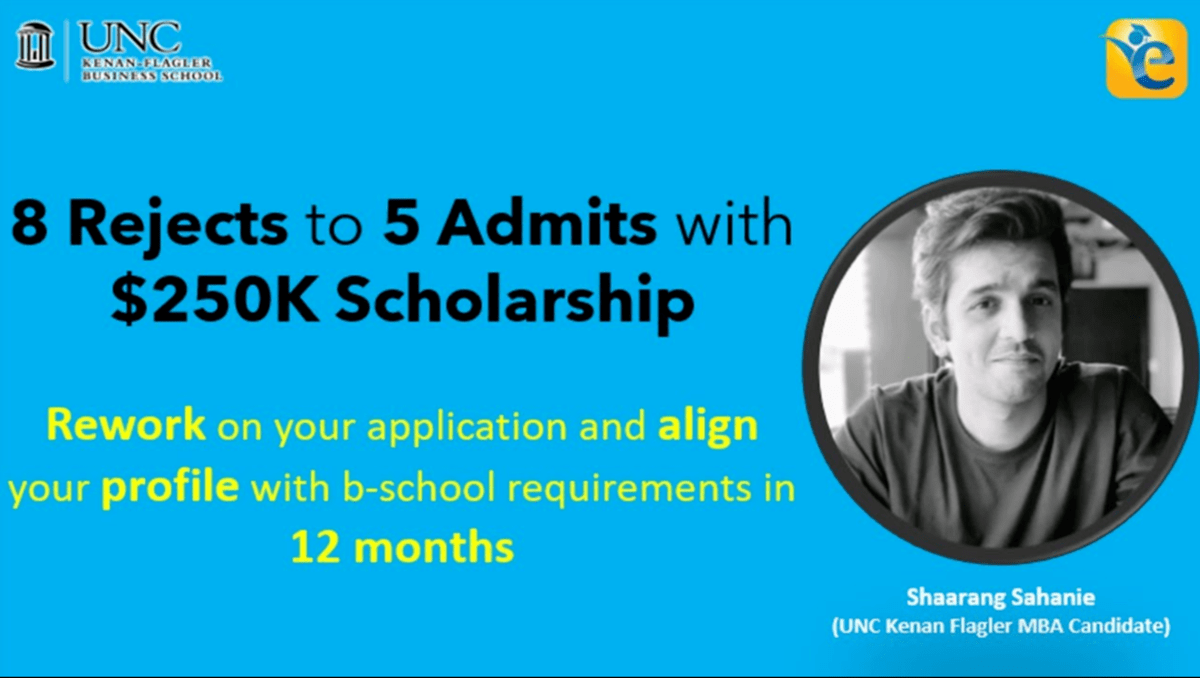The way you frame and articulate your post-MBA goals to the Adcoms will affect your admission decision. Almost all of the top-tier business schools will want you to state your post-MBA career goals (both in the short-term and in the long-term) as well as how their program will help you to attain those goals. However, we have often seen candidates not putting enough thought into their post-MBA goals and how their prior experiences have prepared them to achieve their goals. The result?
They end up jeopardizing their chances of getting an admit and scholarship. Shaarang, a former eGMATer, faced the same consequences.
Coming from an engineering background, Shaarang had an unconventional and impressive work history. After his undergrad, he worked in the investment banking sector and simultaneously started his firm (Codebreak – an analytics start-up that delivered tech-enabled advice to retail investors). After gaining three years of experience (Investment banking + Entrepreneurship), he decided to apply to business schools for an MBA. But he got rejected from all eight colleges because of one reason – Unaligned Post-MBA goals.
After realizing his mistake, Shaarang rebuilt his profile and got into multiple B-schools with about $250,000 worth of scholarships!
Read this article where we outline how Sharaang worked on aligning his post-MBA goals with his prior work experience and how he was able to enhance his MBA profile to get an admit from 5 B-schools, with a $250,000 worth scholarship.
You can also watch this video interview of Shaarang with Rajat, CEO at e-GMAT, to get an overall picture of Shaarang’s MBA Journey and how he got a $250,000 worth scholarship:
How to align your post-MBA goals in your MBA Application?
Shaarang scored high on GMAT (GMAT 740), spent a good amount of time (5 to 6 months) on his MBA Application, drafted compelling essays, and had a strong resume. Moreover, his professional background was diverse and unique. However, he got rejected by 8 B-schools.
Shaarang – I realized that the issue was not my GMAT score or my professional background. It was the way I communicated my goals. I realized that I made my admissions officer’s life hard by talking about complicated plans.
I come from a tech + entrepreneurial background, and my post-MBA goal was to pursue a career in Private Equity/Venture Capital. When you look at the employment statistics at any top B-school, only about 2% – 3% of the class goes into this sector. Most of these people typically have an Investment Banking/Venture Capital/Private Equity background pre-MBA. Thus, my goals seemed disjointed.
After getting rejected from 8 B-schools, Shaarang reworked his MBA profile and aligned his post-MBA goals with past experiences.
Here are the three key steps he followed.
Step 1: Transform your MBA profile

Shaarang had an entrepreneurial background where he acquired a broad set of skills. However, he did not have specific functional skills, and thus his goals were sort of vague. To transform his profile and align his post-MBA goals with his past experiences, he started to work for e-GMAT. At e-GMAT, he got the flexibility to work with each department and figure out which function he was good at.
Shaarang – Working with e-GMAT helped me to:
- Realize that designing/launching products and collecting customer feedback for improving that product is what I love to do. That’s why my post-MBA goal is to be a product manager.
- Identify problem statements in each department, create a process to solve it, and then streamline the process for the future.
- Articulate the impact that I have made in a structured manner. When you work for someone, you are forced to put processes around things that you would have figured out randomly in your own company. Establishing those processes helped me better articulate the impact that I’ve created, which was also evident in my MBA interview. For instance, when someone asked me how I launched an application with 10,000 customers, I could take them step by step and explain exactly what I did.
Step 2: Gain clarity on post-MBA goals

The kind of experiences and processes that Shaarang went through at e-GMAT helped him transform his MBA profile, which was purely entrepreneurship-based.
Shaarang – In the second round of MBA application, my main goal was Product Management at a large tech company. My plan B was operations because my official title was Director of Operations for the duration I worked with e-GMAT. So, my story was as I’ve already done operations pre-MBA, I can get a job in operations post-MBA.
Gaining clarity on his post-MBA goals also helped Shaarang in his MBA interview process.
Shaarang – Interviews were a lot easier as my goals were now aligned. Having aligned goals is also better for me as a candidate because I don’t have to spend ten minutes out of the 30 minutes interview to justify why my plans make sense. This gives me more time to talk about my amazing accomplishments instead of answering why I think I can get a job as a Project Manager. Moreover, the transition from start-up product management to a big tech product management company seemed like a natural sort of progression.
Step 3: Take a course related to your goals

Shaarang realized that to show the admissions committee that his past experiences are aligned with his post-MBA goals, he needs to do a course related to business management. He opted for the HBx CORe program.
Shaarang – I took the HBx CORe program, a three-month intensive course that teaches you the fundamental skills for business decisions and decision-making. Even though the program was intense, I graduated with Honours, which showed the admissions committee that I could handle the MBA environment. Moreover, the decision to take up a business course was also aligned with my post-MBA goals.
Conclusion
Shaarang experience has taught us that aligning your post-MBA goals with your profile is crucial for getting a scholarship and admission from top business schools. Earlier, when his goals were not aligned, he was rejected by eight schools. However, when he clearly defined his post-MBA goals and linked them with his past experiences, he got admitted from 5 schools with a $250,000 worth scholarship.
Through the applicant’s post-MBA goals, Ad-Coms assess whether the applicant has a well-defined plan, is focused on it, and has thought about why they need an MBA in general. Failing to demonstrate the above through applications will showcase that you are unfocused and have not thought about your MBA goals correctly, which translates into one thing – No Scholarship, No admit!
So, to create the best possible post-MBA goals, you must provide a coherent narrative that convincingly connects your personal motivations for getting an MBA with your prior experiences, as well as your short and long-term goals after MBA.
Did you know a high GMAT score can make a stronger case for your application? We can help you with your GMAT preparation. Try out our free trial and get access to free online GMAT prep resources. We are the only GMAT prep company that has delivered more 700+ scores than any other GMAT club partner.















